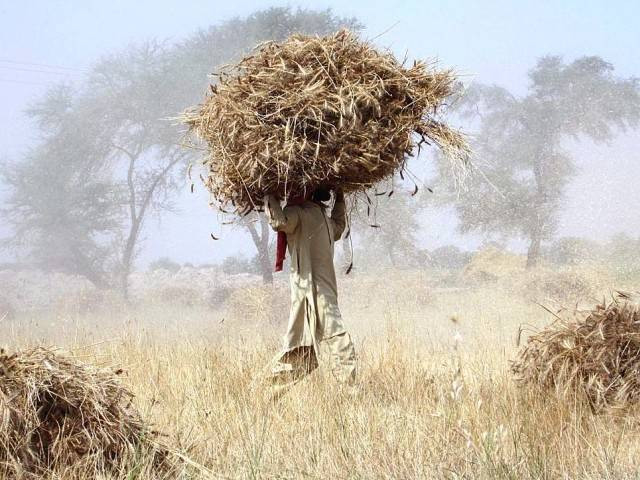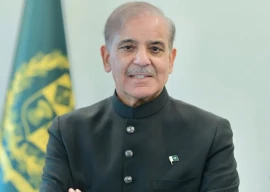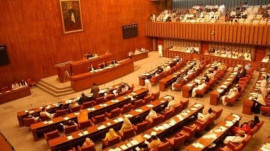
For the first time in decades, the output in agriculture sector - the backbone of the economy - contracted in the outgoing fiscal year, instead of showing growth.
Without reforms, high growth target may remain elusive
More than two-thirds of the growth - 71% precisely - came from the services sector. The government achieved its services sector growth target of 5.7% while the growth in the industrial sector remained slightly higher than the target of 6.4%.
The Gross Domestic Product (GDP) - measure of increase in monetary value of all goods and services produced in one year - is projected to have grown at a rate of 4.7% during the fiscal year 2015-16 ending June 30, according to the National Accounts Committee (NAC).
In its 97th meeting, the NAC approved the provisional growth rate for the outgoing fiscal year, revised down the 2014-15 growth rate to 4% and approved the final growth figure of 2013-14 at 4.1%, according to the NAC documents.
It is the third consecutive year that Prime Minister Nawaz Sharif’s administration has missed the most important and critical economic target.
Budget 2015-16: Govt eyes 5.5% GDP growth next year
For the outgoing fiscal year, the government had set the GDP growth target at 5.5%. The country needs an annual growth rate of 7% to absorb the youth bulge. If the pace of growth were to fall below this rate, it would lead to increased unemployment.
According to sources, on May 18, Pakistan Bureau of Statistics Chief Statistician Asif Bajwa informed Finance Minister Ishaq Dar that the estimated growth rate for 2015-16 was coming close to 4.2%. Bajwa also informed Dar that the revised figures of the previous two financial years were slipping below 4%. Dar, however, did not accept the figures and asked Bajwa to go back to the drawing board.
When contacted, Bajwa neither denied nor confirmed his May 18 meeting with Dar.

“The figure keeps changing until the final figure is approved and the provisional GDP growth rate for 2015-16 is 4.7%,” said Bawja while talking to The Express Tribune.
When agriculture sector contracted, the private and public investment as a percentage of GDP was not significantly increasing.
“Where did the 4.7% growth rate come from?” questioned the Ministry of Finance Economic Adviser Dr Ashfaque Hasan Khan.
Khan said his calculations showed that the growth rate in the outgoing fiscal year was not more than 3.5%.
The 4.7% growth rate was somehow better than the 4.0% achieved last year and slightly better than the International Monetary Fund (IMF) projection of 4.5%.
Planning Commission former deputy chairman Dr Nadeemul Haque argued that there was no difference between 4% or 4.5% growth rate, as there is always room for statistical error of up to 0.3%.
Finance Minister Ishaq Dar will formally announce the provisional growth rate of 4.7% on June 2, with the release of the Economic Survey of Pakistan 2015-16.
Economic Survey 2014-15: Ishaq Dar touts economic growth amidst missed targets
Out of 20 key growth indicators, nine have hit the government’s targeted growth rates while 11 indicators - primarily in agriculture and industrial sectors - remained below expectations.
Agriculture
It was for the first time in decades that the agriculture sector contracted by 0.19% as opposed to the 3.9% growth target by the government. Due to contraction, the agriculture sector contribution to GDP shrank 20.5%. The ruling Pakistan Muslim League Nawaz (PML-N) government has been accused of ignoring this sector that employs close to 37% of the labour force. During the PML-N’s two stints in office in the 1990s, agriculture grew by an average of 2.52% per year, as opposed to overall economic growth during that time averaging 4.06% per year.
Production of both major and minor crops, cotton ginning and livestock, declined compared to the past year. Only forestry and fishing sector grew in the agriculture sector. The cotton production declined to 10.1 million bales - as much as 27.8% less than the last production. Wheat production marginally grew to 25.48 million tons.
Industries
The government achieved the industrial growth target and the output stood at 6.8%. The output of large-scale manufacturing stood at 4.6%, below the official target while small-scale manufacturing grew to 8.2%, slaughtering 3.6%, electricity generation and distribution 12.1%, mining and quarrying 6.8%, and construction 13%.
However, questions have been raised over growth in construction as no sub-sector grew more than 10%.
Services
The services sector, which accounts for more than half the economy, grew by 5.7%. Aided by heavy government borrowing and an increase in the money supply, the financial services sector and government services beat expectations. But other subsectors - transportation, communications, wholesale and retail - missed the growth targets.
Published in The Express Tribune, May 21st, 2016.
Like Business on Facebook, follow @TribuneBiz on Twitter to stay informed and join in the conversation.


















COMMENTS
Comments are moderated and generally will be posted if they are on-topic and not abusive.
For more information, please see our Comments FAQ